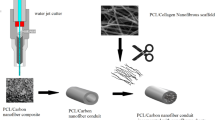Abstract
The complex nature of spinal cord injuries has provided much inspiration for the design of novel biomaterials and scaffolds which are capable of stimulating neural tissue repair strategies. Recently, conductive polymers have gained much attention for improving the nerve regeneration. In our previous study, a three-dimensional (3D) structure with reliable performance was achieved for electrospun scaffolds. The main purpose in the current study is formation of electrical excitable 3D scaffolds by appending polyaniline (PANI) to biocompatible polymers. In this paper, an attempt was made to develop conductive nanofibrous scaffolds, which can simultaneously present both electrical and topographical cues to cells. By using a proper 3D structure, two kinds of conductive scaffolds are compared with a non-conductive scaffold. The 3D nanofibrous core-sheath scaffolds, which are conductive, were prepared with nanorough sheath and aligned core. Two different sheath polymers, including poly(lactic-co-glycolic acid) PLGA and PLGA/PANI, with identical PCL/PANI cores were fabricated. Nanofibers of PCL and PLGA blends with PANI have fiber diameters of 234±60.8 nm and 770±166.6 nm, and conductivity of 3.17×10-5 S/cm and 4.29×10-5 S/cm, respectively. The cell proliferation evaluation of nerve cells on these two conductive scaffolds and previous non-conductive scaffolds (PLGA) indicate that the first conductive scaffold (PCL/ PANI-PLGA) could be more effective for nerve tissue regeneration. Locomotor scores of grafted animals by developed scaffolds showed significant performance of non-conductive 3D scaffolds. Moreover, the animal studies indicated the ability of two new types of conductive scaffolds as spinal cord regeneration candidates.
Similar content being viewed by others
References
M. De vivo, S. Krause, and D. Lammertse, Arch. Phys. Med. Rehabil., 80, 1411 (1999).
J. P. Fisher, A. G. Mikos, and J. D. Bronzino, “Tissue Engineering”, pp.304–317, Taylor & Francis, New York, 2007.
K. Straley, C. Po Foo, and S. Heilshorn, J. Neurotrauma, 27, 1 (2010).
P. A. Lim and A. M. Two, Ann. Acad. Med. Singapore, 36, 49 (2007).
B. Q. Palsson and S. N. Bahatia, “Tissue Engineering”, Pearson Education, 2004.
B. Shrestha, K. Coykendall, Y. Li, A. Moon, P. Priyadarshani, and L. Yao, Stem. Cell Research & Therapy, 5, 91 (2014).
N. T. Hiep and B. T. Lee, J. Mater. Sci.: Mater. Med., 21, 1969 (2010).
B. L. Du, C. Zeng, W. Zhang, D. Quan, and E. Ling, J. Biomed. Mater. Res., 102A, 1715 (2014).
F. Zamani, M. Latifi, M. Amani-Tehran, and M. A. Shokrgozar, Fiber. Polym., 14, 568 (2013).
F. Jahanmard, M. Amani-Tehran, F. Zamani, M. Nematollahi, L. Ghasemi, and M. H. Nasr-Esfahani, Int. J. Poly. Mat. Poly. Biomat., 63, 57 (2013).
F. Zamani, M. Amani-Tehran, M. Latifi, and M. A. Shokrgozar, J. Mater. Sci.: Mater. Med., 24, 1551 (2013).
F. Zamani, Ph. D. Dissertation, Amirkabir University of Technology, Tehran, 2013.
W. He, Z. Ma, W. Teo, Y. Dong, P. Robless, T. Lim, and S. Ramakrishna, J. Biomed. Mater. Res., 90A, 205 (2009).
F. Zamani, M. Amani-Tehran, M. Latifi, M. A. Shokrgozar, and A. Zaminy, J. Biomed. Mater. Res., 102A, 506 (2014).
M. J. Moore, A. Friedman, and E. B. Lewellyn, Biomaterials, 27, 419 (2006).
A. G. Krych, G. E. Rooney, and B. C. Schermerhorn, Acta Biomaterialia, 5, 2551 (2009).
E. Llorens, E. Armelin, M. Madrigal, L. Valle, C. Aleman, and J. Puiggali, Polymers, 5, 1115 (2013).
L. Ghasemi-Mobarakeh, M. P. Prabhakaran, M. Morshed, M. H. Nasr-Esfahani, and S. Ramakrishna, Tissue Eng., 1A, 1 (2009).
M. P. Prabhakaran, L. Ghasemi-Mobarakeh, G. Jin, and S. Ramakrishna, J. Biosci. Bioeng., 112, 501 (2011).
A. Al-Majed, C. M. Neumann, T. M. Brushart, and T. Gordon, J. Neurosci., 20, 2602 (2000).
C. Y. Ho, C. H. Yao, W. C. Chen, W. C. Shen, and D. T. Bau, Evidence-Based Complementary and Alternative Medicine, 2013, Article ID 514610 (2013).
M. C. Lu, C. Y. Ho, S. F. Hsu, H. C. Lee, J. H. Lin, C. H. Yao, and Y. S. Chen, Neurorehabil. Neural. Repair., 22, 367 (2008).
L. M. Y. Yu, N. D. Leipzig, and M. S. Shoichet, Mater. Today, 11b, 36 (2008).
C. E. Schmidt, V. R. Shastri, J. P. Vacanti, and R. Langer, Proc. Natl. Acad. Sci., 94, 8948 (1997).
P. R. Bidez, A. G. Macdiarmid, E. C. Venancio, Y. Wei, and P. I. Lelkes, J. Biomater. Sci. Polym., 17, 199 (2006).
Q. Z. Yu, M. M. Shi, M. Deng, M. Wang, and H. Z. Chen, Mat. Sci. Eng., 150B, 70 (2008).
A. Yang, Z. Huang, G. Yin, and X. Pu, Colloid Surf. BBiointerfaces, 134, 469 (2015).
L. Ghasemi-Mobarakeh, M. Prabhakaran, M. Morshed, M. H. Nasr-Esfahani, H. Baharvand, S. Kiani, S. Al-Deyab, and S. Ramakrishna, J. Tissue Eng. Regen. Med., 5, 17 (2011).
C. H. Wang, Y. Q. Dong, K. Sengothi, K. L. Tan, and E. T. Kang, Synth. Met., 102, 1313 (1999).
S. Kamalesh, P. Tan, J. Wang, T. Lee, E. Kang, and C. H. Wang, J. Biomed. Mater. Res., 52, 467 (2000).
I. D. Norris, M. M. Shaker, F. K. Ko, and A. G. MacDiarmid, Synth. Met., 114, 109 (2000).
M. Li, Y. Guo, Y. Wei, A. G. MacDiarmid, and P. I. Lelkes, Biomaterials, 27, 2705 (2006).
M. Yanilmaz and A. S. Sarac, Text. Res. J., 84, 1325 (2014).
D. M. Basso and M. S. Beattie, J. Neurotrauma., 12, 1 (1995).
Author information
Authors and Affiliations
Corresponding author
Rights and permissions
About this article
Cite this article
Zamani, F., Amani-Tehran, M., Zaminy, A. et al. Conductive 3D structure nanofibrous scaffolds for spinal cord regeneration. Fibers Polym 18, 1874–1881 (2017). https://doi.org/10.1007/s12221-017-7349-7
Received:
Revised:
Accepted:
Published:
Issue Date:
DOI: https://doi.org/10.1007/s12221-017-7349-7




